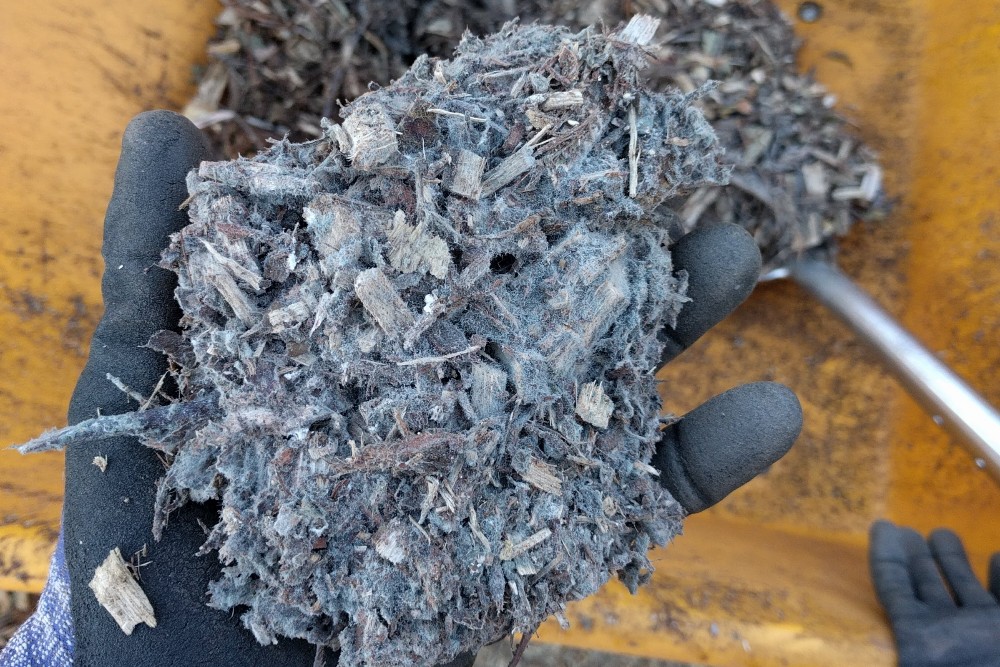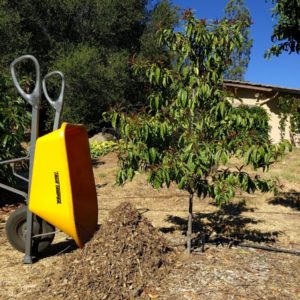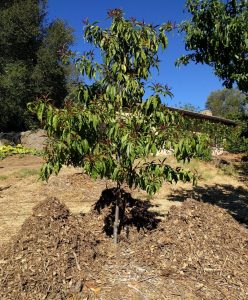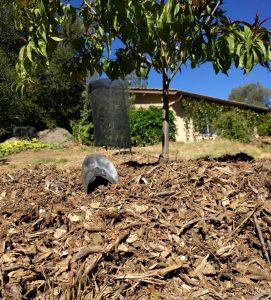Almost any mulch under a fruit tree is better than no mulch, but there are many ways in which wood chips are the best of mulches.
Wood chips are what comes out of a chipper machine when a tree trimmer puts branches through it. Wood chips are bits of leaves, twigs, bark, and wood. It’s all parts of a tree (or shrub) ground up.
This amalgamation is better as a mulch than just bits of one part. For example, an advantage that wood chips have over just leaves is that wood chips don’t blow away. One way that wood chips are better than just bark is that wood chips stick together and don’t slide down slopes as much (especially as fungi and bacteria grow on them and bind them together as seen in the photo above). And what I like about wood chips compared to compost is that wood chips don’t compact as much and wood chips are also more receptive to water (in the form of rain or irrigation) since the particles of wood chips are bigger, chunkier.
But again, leaves, bark, compost as mulch under fruit trees are good. It’s just that I find wood chips to be even better.
So, you get your hands on some wood chips and it’s time to spread them under your fruit tree. How to go about that?
How much wood chips to add as mulch under a fruit tree?
Dump the chips beside the tree.
One, or two, or three or more loads.
I prefer to add enough for a layer at least three inches thick, as the chips will settle and break down quickly. I’ve added as much as a foot at one time. Even a layer of one inch is useful, but in terms of efficiency and maximum benefits, it’s usually best to make a new layer of around six to eight inches.
Under this tree I added about seven inches. In a month or two, I know from experience, it will shrink down to nearly half that depth.
Where to place the wood chips as mulch under a fruit tree?
There’s no benefit — but there is risk of crown diseases — in placing the mulch up against the trunk. So spread the chips from a couple inches from the trunk out to the canopy edge, or a little farther. I always try to go at least a few inches farther.
Basically, the mulch should be covering the soil where most of the tree’s roots are. This is obvious if we remember why we’re putting mulch under the tree.
What are the benefits of wood chips as mulch under a fruit tree?
The benefits of this wood-chip mulch are many. The wood chips suppress weeds, conserve soil moisture, reduce rain and irrigation runoff, feed the worms and microorganisms in the soil below thereby adding fertility, keep the soil cooler in summer, reduce compaction, and suppress some disease-causing microorganisms.
(Read more about the benefits of wood chips as mulch in this paper by Linda Chalker-Scott of Washington State University.)
I’ve seen most of these benefits with my own eyes on my own trees and those I’ve visited.
But most of these benefits can only occur if the wood chips are placed over the soil where the tree’s roots are. How do we know where the tree’s roots are? You don’t have to dig. Follow the water. Roots only proliferate where there is moisture in the soil, so place the bulk of the wood chips over the soil that is wetted by your irrigation.
This tree of mine, a SpiceZee nectaplum, is watered with a mini-sprinkler out near its canopy edge, so that’s where I put the chips.
By the way, if you’re using a dripline to irrigate your tree, the dripline can stay under the mulch or above. Either way works perfectly fine. It’s an aesthetic decision that’s up to you.
And by the way, since wood chips keep the soil under them moist for longer, you can water the tree less often than if it weren’t mulched.
When to add wood chips as mulch under a fruit tree?
Is there a best time of year to add wood chips as mulch under a fruit tree? I end up adding wood chips under my trees whenever I have the time and the wood chips, but if I have the luxury of scheduling it, my favorite time of year to add them is in winter because moving and spreading them is a less dusty operation and the rains will soak the chips for free.
It’s now late summer as I’m adding these wood chips to this little SpiceZee nectaplum tree so I have to soak them myself. I could do this by running my mini-sprinkler or by hand watering. But if I don’t soak the chips, then my next normal irrigation won’t get much water down to the roots below because the chips will soak it up.
OK, that’s it. Job done. Now my tree is going to grow and fruit like crazy and it will never have weeds under it, I’ll barely have to water it, and it will never get a disease. If only.
Wood chips as mulch under fruit trees are the best option that I know of but they aren’t magical and they don’t last forever. I’ve found the need to add new wood chips under my trees approximately once a year. That task will never end. Yet, after many years of adding chips, a layer of dark, rich soil forms between the chips and the native soil. It’s like the layer of humus you find if you scratch back the duff on the ground in a forest. Pretty cool that we can artificially create such a healthy root environment for our trees.
Worries and downsides of wood chips as mulch
Are there any kinds of trees that don’t make good wood chips for mulch? Not that I know of. Eucalyptus, for example, is sometimes rumored to be toxic or allelopathic (inhibit the growth of other plants), but I’ve used lots of eucalyptus wood chips and never seen such problems. Also, conveniently, James Downer and Ben Faber of the University of California wrote a paper on their study of eucalyptus as mulch and found that “Fresh eucalyptus is an excellent mulch . . . “
Can wood chips spread diseases or insect pests? Maybe a tree that was cut down and chipped had a disease and those chips will infect your tree, for instance. Sounds plausible, but I’ve never experienced it and most university researchers I’ve talked to or whose studies I’ve read say that the risk is nil to low.
(Read this article called, “The Myth of Pathogenic Wood Chips.” But also see “Mulch and the Spread of Plant Pathogens.”)
There is always a risk though. And if it scares you, then instead of getting wood chips from a tree trimmer and using them as mulch immediately, you can let the pile sit and dry out and decompose for a while or you can get wood chips that have already been thoroughly composted. See my post on where to get such wood chips: “Where to get wood chips for mulch.”
You might also like to read my posts:








i have a question…for large mature avocado trees…is it still beneficial to mulch or not recommended. i know avocado have feeder roots at the top but i thought larger mature trees don’t have it anymore?
i figured mulching is still better than no mulching (or having the area covered in weeds)
Hi Johnny,
Mulch is still beneficial for large mature avocado trees. It’s true that if they’re healthy and cared for properly, then they’ll have a “self-mulch” of leaf litter under them, but it is still beneficial to add some coarse material like wood chips every once in a while. One reason is that the wood chips help the leaves break down as well as stay down when there’s wind.
Actually, older avocado trees have more shallow feeder roots than young trees, as long as the older trees are healthy and cared for properly. Young avocado trees send their roots out down deeper at first, and only later do they develop the shallow mat of feeder roots. This is one reason that drip irrigation tends to work better on young trees compared to large older trees.
Hi Greg,
Thank you for all your advice. I love your blog. Last year, my mother found some bagged mulch that I had bought at Home Depot for some landscaping and used it to mulch some of my fruit trees. I was a little worried, but when I looked at the product information online, the company representatives were telling people that it is safe to use around fruits and vegetables.
Months later, and the natural mulch that I got from someone’s chip drop and put around some other trees has shrunk way down, but the bagged mulch seems to be about the same. What IS this bagged mulch stuff and is it really safe around my fruit trees?
Thanks!
Hi Erin,
Thanks! While I don’t know what you bought from Home Depot, most of the bagged products I’ve seen there and at nurseries and garden centers everywhere consists primarily of ground bark. There’s nothing unsafe about using bark as mulch around fruit trees or vegetables, but there are some downsides compared to wood chips (which are ground bark, wood, twigs, leaves — every part of a tree).
One downside of bark is that it breaks down very slowly, just as you noticed. Another downside is that it doesn’t improve the soil below as much. This is both because it breaks down very slowly (compared to other tree parts — especially leaves) and because it is just one part of a tree.
Different tree parts consist of different materials which are eaten by different microbes, and the melange that is wood chips makes for a smorgasbord of food for various microbes that is broken down relatively quickly, and which eventually adds a lot of different nutrients and increases the soil life below.
So bark isn’t a bad or dangerous mulch, but wood chips are way better if you want to increase soil fertility and soil life.
Interesting! Thanks for the quick reply. Luckily, I found another person with excess wood chips today, so I mixed some of them in with that bagged mulch.
How long do tge wood chips have to season before I can spread them under our fruit trees? Our trees are between 7 and 1 year old?
I just got a load of 75% pine wood chips with needles. I found some differing information about using pine wood chips/needles in that some say it makes the soil acidic and others say its fine and has no effect on the soil PH. Bottom line is I have avocado, citrus and some other deciduous fruit trees. In your opinion, is it okay to use the pine wood chips/needles on these trees?
Thanks in advance…
Hi Eric,
I don’t think you have anything to worry about. I’ve used lots of pine wood chips and never seen negative effects. Have a look at the link in the post above to the article written by Linda Chalker-Scott. In it she addresses this question and says basically, don’t worry about it.
Even if the pine wood chips did slightly acidify your soil, that might be a good thing if your soil and irrigation water are alkaline.
Awesome, thanks for the response…
Question, I mulch all of my citrus trees heavily and wanted to make sure that’s recommended. The reason I ask is because we planted a Valencia Orange tree a few months ago and it has some yellow leaves and no new growth. I saw some information online to NOT mulch citrus trees at all in order to allow them to breath. Is this true? The area I planted the tree in in has clay soil so I’m assuming the yellow leaves are from too much water (I only watered it twice, once at planting and once a few weeks ago but it is still moist under the mulch).
Thanks for all the info
Hi Eric,
I’m glad you wrote up this observation. It’s a topic I’ve been thinking about for a while. I don’t feel like I’ve gotten to the bottom of it, but I have some hunches.
Most of my citrus trees are also mulched heavily with wood chips. Some of them also have foliage that is not as deep green as would make me comfortable — especially in winter and spring, and especially trees in their first couple years.
For example, I’ve got two Kishu mandarins. One is about five years old while the other is only in its second year. Only now is the young Kishu starting to have leaves as green as the older tree; and only now is it starting to put on significant new growth.
My suspicion is that the thick layer of wood chips keeps the soil under the young tree cooler than it would like. This pattern has occurred on other young citrus trees in my yard too.
However, my older citrus trees that are heavily mulched don’t seem to care. Their leaves are the green that I expect. They grow like weeds, for the most part.
But I think you’re onto something with the wetness of the soil under the mulch too, wet soil being cooler than dry soil. Plus, clay soil takes longer to warm up in the spring and summer than sandy soil. So you may have a lot working against you here and scraping away the mulch on that young tree might help, in the short term at least.
Maybe the smartest thing to do is to not mulch a newly planted citrus tree for its first year or so, especially in heavy soil.
Thanks for the reply…I’ll try scraping away the mulch and I’ll let you know what happens
Thanks for the help
A thought. Greg, you had mentioned a few articles on soil heat and how it could benefit root growth. This was in response to a question about using black dyed wood chips. Maybe for this person, using a layer of black wood chips would help warm up the soil would be a sensible strategy.
I like that, Dan. I hadn’t thought about that, but it certainly seems like it could help.
good to hear a concensus opinion that pine needles are OK for mulch. I specifically try to use conifer chips/needles for my blueberries which are acid soil loving. I work on the theory that this year’s mulch (for weed deterrence and moisture preservation) is next year’s compost (for soil enhancement/amendment). Full disclosure…..I have not done pH testing before and after mulching with conifer derived chips and needles…..but the blueberries DO seem very happy.
I have newly planted advocado trees that currently just have bags of Vigora brown colored mulch and some fine mulch that I got free from LA city sanitation dept. I just purchased a used small electric chipper and was wondering what the thoughts were on putting ivy in my mulch mix. I would mix it with some bags of brown mulch, pepper tree clippings, and some hedge tree. The area that I am putting this currently has grass that I am removing. I am not going to disturb the 4ft circle I have around the tree. I also have a palm tree, what are the thoughts on that? I also have a chain saw, so how big can mulch chunks be since my $40 shredder only takes 1 1/2 inch branches?
Hi Paul,
I’m not as particular about mulch as some people. In addition to the pure tree trimmings that one gets from a chipped tree, I put or leave all sorts of stuff under my trees such as discarded fruit, random garden clippings, all tree and vine prunings, all weeds that don’t have seeds.
As long as that ivy doesn’t root and grow, I don’t see why it would be a problem mixed into your mulch. And palms can often be fine except that they sometimes have thorns and they take a long time to break down. So just be on the lookout for that.
If you’re going for a uniform appearance or you’re running a mower over the mulch or you have small kids that might trip, then you don’t want huge chunks of wood or long sections of vine. Otherwise, there’s nothing dangerous about leaving pieces very big; it just takes longer to break down, but that can be a positive because the mulch will last longer.
can i use ceder wood chip on Apple trees.
Hi Barbara,
If you’re asking about using chipped wood from a cedar tree as mulch around an apple tree, I can’t imagine why not. I haven’t done it myself, but I can’t think of any reason why it wouldn’t work fine.
I just read all your blogs and your approach fits my views on “life” well.
I have an abundance of 3-yr old eucalyptus chips.
Thankyou.
Thanks for taking the time to write that, Sue!
Hi, I could not find the mulch I see everyone showing that they use for avocado trees. So I bought micro bark mulch from Green Thumb. Now after reading your post regarding the bark mulch I wished I found the right kind of mulch. Could you please share with me the name of the mulch and where to get it. Also, if I have a dead bush can I cut it up and use that too as mulch?Thank you
Erase the question about the using the dead bush I read your answer in another post. Thanks!
Hi Greg,
I am getting some clean euc wood (no leaves) chips. How far away should they be placed from avocados, citrus, and stone fruits. All are young (approx year+) trees. I want to use it to cover the pathway, but am concerned the chips might be damaging to the fruit trees. I read that you used euc chips, but how far did you keep them from the trees? It will be going over pine needles and chips from last year, the trees have done quite well so far.
Thanks so much
I wasn’t sure where to post this question, so I picked here. I would like to know your thoughts on weed guard type products. I have three fruit trees which have weed guard, or some sort of weed suppression fabric, then mulch on top. All three are bordered on most or all sides by grass/weeds. We have some long term planning to do in terms of yard landscaping, but for now much of our 1/4 acre is grass.
Plum – this tree has never done well in terms of producing, but it has grass within a couple feet, and is between a huge ficus and a 60+ year old lemon. I’m guessing those trees steal a lot of its water. Its about 6 yrs old, 10+’ high but very narrow, maybe only 3-4′ dia tops.
Pomegranate – 6.5 years old, does fantastic. 9′ tall, 7′ wide and very full, very much a bush as opposed to a tree.
Persimmon – 3.5 years old, bore very well last year. 6′ tall, 4-5′ diameter, but not terribly full. I guess comparing it to its nearest neighbor the pomegranate its hard to compare, but I shouldn’t since they’re very different trees.
So here’s the situation. The soil under the plum and persimmon just look matted down. The soil under the pomegranate looks more textured.
I’m considering removing the weed guard from all three trees, or perhaps just letting it “wear out” and not replacing it. I’ve read mixed reviews elsewhere online, some people swear by it under mulch, others say no improvement. In my case the weeding in these areas is very minimal. I recently removed much grass/weeds from under my 10+’ Hass tree and I’ll at least have a bit of data for long term weed abatement here.
Are there any downsides to having the weed guard under the mulch, other than the time and $ I already spent on it?
Hi Matt,
Your questions remind me of the planting of fruit trees a friend did where he put down a weed barrier fabric under all his trees. I helped him rip much of it out a couple years ago.
What we didn’t like about it was that there was little ability for interaction between the mulch on top and the soil below. So, for example, worms couldn’t come up into the mulch and help break it down and feed the tree roots. The soil below was also compacted. I believe that if the weed barrier hadn’t been there then worms and other small critters would have been living, working in, and improving the soil structure and incorporating the mulch into it. I’ve seen this happen everywhere else there has been mulch but no weed fabric.
The short of it is, if you can get your hands on enough mulch, then putting down a handful of inches below the trees will suppress almost all kinds of weeds as well as any fabric that I know of. Then you get none of the downsides of the fabric.
Thanks Greg, there is a lot of wisdom in those words. I’ve already got a decent amount of mulch, will add more over time too.
Is it good practice to chip the prunings off fruit trees directly under them? I’m thinking about diseased prunings. I’ve heard by chipping them there is minimal risk of disease returning to the tree, is this true?
Hi Rene,
Many sources advise removing diseased wood and not leaving it at the base of the tree. For example: http://ipm.ucanr.edu/PMG/GARDEN/FRUIT/CULTURAL/sanitation.html
That sounds reasonable, but I don’t know that it is based on any hard evidence that the prunings actually contribute to further infection. I haven’t seen any formal studies on the topic.
I suppose that if I were sure I were cutting out diseased wood, I would take the prunings away and chip them elsewhere rather than leave them under the infected tree, just to be safe. That being said, I haven’t always followed this practice in my own yard and I haven’t noticed any increased infections — but I also haven’t dealt with much disease in my trees so I wouldn’t extrapolate much from my experience here.
I live in SCal and have 15 fruit trees of various types citrus, deciduous, and tropical all on drip irrigation. It’s time to put mulch again, have used free stuff that tree trimmer companies offer by the truck load. Problem is it deteriorates after 2-3 years as much of it are leaves. I’d like to put longer lasting mulch so I don’t have to do it as often as about 9-10 cu. yd. is involved (I’m a DIY senior). I’m considering buying playground wood chips which should last longer. I’m concerned that termites will find it a good food source, as I’ve read, as termites are prevalent in this area, currently attacking portions of my wood fence. I’m thinking of applying a thinner 2” layer to minimize possible termite infestation. What are your thoughts about this?
Hi Steve,
I experience a similar need to still add wood chips every couple years, but I have also found that the frequency reduces over time. I need to replenish the wood chips less often now compared to when I began mulching the trees.
If your main goal is to need to add mulch less often, then the playground wood chips should achieve that. Bark should also.
The only source of information on the termite issue that I have found that I would trust is this one from Linda Chalker-Scott at Washington State: http://pubs.cahnrs.wsu.edu/publications/pubs/fs160e/
In it she says that termites on not very attracted to wood chips in general.
Weed suppression and moisture conservation are just 2 benefits from mulching. Feeding the soil and its micro organisms is also an essential plus. So wouldn’t the fact the mulch is NOT lasting actually evidence that it is doing its job well?
(I’m also a DIY senior by the way). Big believer in mulching!
Do wood chips from pepper trees (the kind that grows everywhere in Southern California) have any problems that you know about?
I’ve never seen a problem with using wood chips from pepper trees, and I’ve used a lot of them. The only thing I’ve noticed is that a number of seedlings do end up germinating, but they’re easy to pull out.
Thanks!
Hi Greg,
Thanks for all the great advice.
I used partially composted wood chips under my avocados last year and it’s developed into a fairly solid inch-thick layer on top of the soil:
https://photos.app.goo.gl/zxRhP6uvbvny51Dr7
I’m concerned it’s creating a water barrier (water runs sideways when initially watering) and an wondering if it should be broken up a bit / turned, however I also see small white roots so not sure if breaking it up does more harm than good?
Thanks,
Mike
I don’t know if this is relevant but found an article referencing “hydrophobia” —
https://www.leaflimb.com/when-good-mulch-goes-bad/
I’m planning on adding wood chips under my citrus trees: grapefruit, meyer lemon, juice orange & tangerine. Will be doing it in the next couple of weeks. Two questions: How do you check to see if the trees need watering, especially here with Bakersfield’s temperature in the summer or during the winter? This last November & December we had almost two & half inches of rain within two weeks. With the chips down they hold the water a lot longer, both my lemon & grapefruit trees are showing stress from all the rain we had.
With the wood chips down around the trees, how do you go about fertilizing the trees? I fertilize three times a year.
I’m learning more from your post then I do from the County Extension or nurseries.
Thank you, joe
Hi Joe,
I’ll tell you what I do with my own citrus. I have them all on drip and I calculate the water they need and apply it, and I rarely check the soil moisture. I just judge my watering based on the reactions of the trees. Citrus cup their leaves when they’re thirsty. And the leaves will start drooping if you’re overwatering.
Here’s a post to get a rough idea of how much to water a citrus tree: https://gregalder.com/yardposts/how-much-to-water-a-fruit-tree-in-southern-california-roughly/
And here’s a watering table for citrus that might help you (see page 9): https://homeorchard.ucanr.edu/files/140618.pdf
I plan to write a post on watering citrus specifically soon.
I don’t fertilize my citrus beyond keeping a thick layer of wood chips under them. I’ve found that they produce fine without anything else added. That might work for you too, but it does depend on the soil you’re working with in your yard.
Hi, thank you for sharing the vast resource which you have single-handedly created.
1) What happens with the avocado leaves when you add mulch? Do you just put the mulch on
top of the leaves? 2) Do you mulch your orange trees? If so, how do your orange trees respond to mulch? 3) How many years have you been installing mulch?
Hi Leaf, here’s my experience. For 1) avocado leaves certainly can be part of the mulch. Just put mulch on top of the dead ones, or mix the mulch and leaves if you like. But don’t feel the need to remove them to mulch.
2) My experience with mulching my dwarf navel orange has been very positive. I use the term mulch loosely, as I put most any yard waste (as well as almost all the orange peels) under my tree. Grass clippings, weeds that I’ve pulled from other areas of the yard, bouganvilla that I’ve put through the chipper, and just plain wood chips. I have nothing growing under this tree (in terms of weeds, etc) and it yields 200+ oranges every year. All from a 7′ tall x 10′ wide tree that’s very easy to pick. YMMV.
Since its dwarf, all the yard waste and such I put under is essentially invisible. Most oranges don’t reach to the ground, so you may not feel the desire to see tons of orange peels in your yard.
Thanks Leaf and Matt,
I do the same as Matt. In my current yard, I’ve been adding wood chips under my citrus for the eight years we’ve been here.
Thanks so much for this. I had a huge load of mulch delivered from a company (Chipdrop) that you let me know of on this blog. I was so disappointed to find out it was mostly eucalyptus thinking it was toxic. I have 2 huge piles that I can now use! Thanks so much for the myth buster. I love it when that happens!
Hi Greg: Great post and very timely for me. I don’t have any citrus/fruit trees rather a large Fuerte. It’s been topped with good soil and toppers over the years but not any mulch as I wasn’t really sure what product to use and how it would affect irrigation. Your articles and threads really sold me on using a wood chip mulch. Your cautions about the trunk and thickness to cover with are valuable to me. Thank you again for a great post. Also weeks back on your Avocado tour you showed the grower who has “heaped” wood chip mulch for years under his avocado tress with great results. BR, Joe Oside